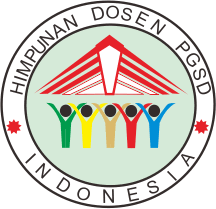Analisis kemampuan berpikir kritis peserta didik dalam menemukan ide pokok teks non fiksi deskripsi kelas IV sekolah dasar
Abstract
This research was undertaken to analyze of critical thinking skills in finding the main idea of a nonfiction descriptive text of IVth grade students in SDN Bratan 1 No. 71 in the academic year of 2021/2022. Critical thinking skill emphasizes of ability to understanding the question, to make a reason based on fact to make a conclusion, using the information to problem solving to give a verification, and to evaluate their final result. Critical thinking skill are needed for students to dealing some real life problems in the 21th century. This research uses descriptive qualitative research methods. The subjects of this research were teachers and students of IV.Bth grade in SDN Bratan 1 No. 71 in academic year 2021/2022. The data collection techniques used include test, interviews, and documentation with data validation used triangulation technique. The data analysis used Miles-Huberman’s interactive analysis model. This data analysis consists of four main components such as data collection, data reduction, data presentation, and conclusions. The results of this research shows that the analysis of critical thinking skill at SDN Bratan 1 No. 71 is in the critical enough criteria. The percentages of the analysis of critical thinking skill of IV.Bth grade in SDN Bratan 1 No. 71. This is the percantages for each indikator. The percentage at the focus obtained is 43%. And the indicator of reason obtained is 57%. And in the inference indikator obtained is 21,4%. And in the situation indicator obtained is 14,3%. And in the clarity indicator obtained is 14,3%. And in the overview indicator obtained is 42,8%. The most dominant indicator is focus, reason, and overview
Keywords
Full Text:
PDFReferences
[1] N. A. Purba, “Kemampuan Menemukan Ide Pokok Pargraf Dalam Berbagai Jenis Wacana Dalam Naskah Soal UAS Oleh Siswa Kelas IX SMP Negeri 5 Percut Sei Tuan,” J. Bina Gogik, 5 (1), pp. 16–25, 2018.
[2] Uci Sugiarti, “Pentingnya Pembinaan Kegiatan Membaca Sebagai Implikasi Pembelajaran Bahasa Indonesia,” J. Bhs. Sastra, 1 (1), pp. 99–117, 2012.
[3] R. Triandy, “Pembelajaran Mengidentifikasi Ide Pokok Dalam Artikel Dengan Metode Inquiry Pada Siswa Kelas X Sma Pasundan 2 Bandung,” LITERASI J. Ilm. Pendidik. Bahasa, Sastra Indones. dan Drh., 7 (2), pp. 143, 2017.
[4] E. N. AnggitaSari, R. Rukayah, and S. Kamsiyati, “Analisis motivasi belajar siswa dalam menemukan gagasan pokok pada paragraf teks bacaan kelas IV D di sekolah dasar,” Didakt. Dwija Indria, 9 (4), pp. 2–7, 2020.
[5] F. Inggriyani and N. Fazriyah, “Pengaruh Berpikir Kritis Terhadap Kemampuan Menulis Narasi Siswa Kelas V Di Sekolah Dasar,” J. Pendidik. Sekol. Dasar, 3 (2), p. 105, 2017.
[6] Sariyem, “Kemampuan Berpikir Kritis dan Minat Baca dengan Kemampuan Membaca Kritis Siswa Kelas Tinggi SD Negeri di Kabupaten Bogo,” J. Pendidik. Dasar, 53 (9), pp. 1689–1699, 2016.
[7] R. Rachmadtullah, “Kemampuan Berpikir Kritis Dan Konsep Diri Dengan Hasil Belajar Pendidikan Kewarganegaraan Siswa Kelas V Sekolah Dasar,” J. Pendidik. Dasar, 6 (2), pp. 287, 2015.
[8] M. Fahrizal, J. I. S. Poerwanti, and D. S. Wahyuningsih, “Penerapan Model Pembelajaran Cooperative Learning Tipe Team Games Tournament (TGT) untuk Meningkatkan Keterampilan Berpikir Kritis Pembelajaran IPS Peserta Didik Kelas V Sekolah Dasar,” J. Pendidikan Indonesia, 6 (1), pp. 29–35, 2020.
[9] A. Fati and J. Daryanto, “Analisis keterampilan berpikir kritis dalam pemecahan masalah matematika berdasarkan teori robert h ennis pada kelas v sekolah dasar,” Didakt. Dwija Indria, 9 (6), pp. 29-35, 2020.
[10] H. Affandy, N. S. Aminah, and S. Supriyanto, “Analisis Keterampilan Berpikir Kritis Siswa Pada Materi Fluida Dinamis di SMA Batik 2 Surakarta,” J. Mater. dan Pembelajaran Fis., 9 (1), pp. 25–33, 2019.
[11] S. Sutarto, “Teori Kognitif dan Implikasinya Dalam Pembelajaran,” Islam. Couns. J. Bimbing. Konseling Islam, 1 (2), pp. 1, 2017.
[12] S. W. Prameswari, S. Suharno, and S. Sarwanto, “Inculcate Critical Thinking Skills in Primary Schools,” Soc. Humanit. Educ. Stud. Conf. Ser., 1 (1), pp. 742–750, 2018.
[13] A. Fridanianti, H. Purwati, and Y. H. Murtianto, “Analisis Kemampuan Berpikir Kritis Dalam Menyelesaikan Soal Aljabar Kelas Vii Smp N 2 Pangkah Ditinjau Dari Gaya Kognitif Reflektif Dan Kognitif Impulsif,” AKSIOMA J. Mat. dan Pendidik. Mat., 9 (1), pp. 11, 2018.
[14] M. Habibah, “Analisis Kemampuan Kognitif Peserta Didik (Studi pada Lembaga Pendidikan MI al-Kautsar Yogyakarta),” J. Islam. Educ. Res., 1 (2), pp. 28–38, 2020.
[15] N. D. Juniarti and N. T. Renda, “Penerapan Model Problem Solving Untuk Meningkatkan Hasil Belajar Matematika,” J. Ilm. Pendidik. Profesi Guru, 2 (3), pp. 248–257, 2019.
Refbacks
- There are currently no refbacks.


